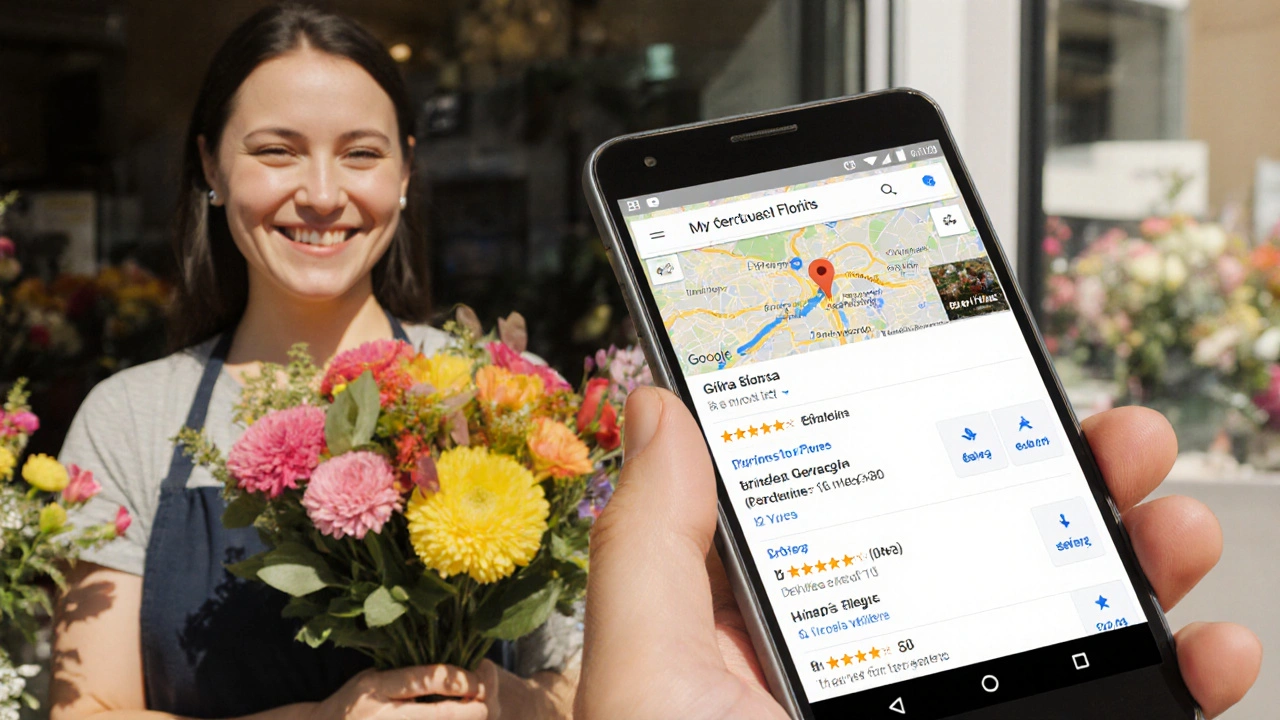Google Business Profile Optimizer
Profile Health Check
Your Profile Score
Personalized Improvement Plan
Most small businesses think they need a fancy website or a viral TikTok video to get noticed online. The truth? It’s not about being loud-it’s about being found. If your website isn’t showing up when someone searches for what you offer, you’re invisible. That’s where internet marketing comes in. It’s not magic. It’s a set of practical, repeatable steps that turn strangers into customers-without spending thousands on ads.
Why Your Online Presence Isn’t Working
Let’s say you run a local bakery in Adelaide. You’ve got beautiful cakes, great reviews, and a website that looks like a 2012 template. You post once a week on Instagram. You’re wondering why no one’s walking in. The problem isn’t your cakes. It’s that people aren’t searching for "Adelaide bakery" and finding you. Or worse-they find you, but your site takes 8 seconds to load, and the menu isn’t clear.
Internet marketing fixes that. It’s not about posting more. It’s about being in the right place, at the right time, with the right message. Google handles over 90% of search traffic globally. If you’re not optimized for search, you’re handing your customers to competitors. Social media? It’s a conversation starter, not a sales funnel. Without search visibility, your Instagram followers won’t turn into buyers.
What Internet Marketing Actually Includes
Internet marketing isn’t one thing. It’s a mix of tactics that work together. Here’s what actually moves the needle:
- Search Engine Optimization (SEO): Making sure your website shows up when people search for your products or services. This includes clean site structure, fast loading speed, and content that answers real questions.
- Content Marketing: Writing blogs, guides, or videos that help people solve problems. A post like "How to Choose the Perfect Birthday Cake in Adelaide" brings in people actively looking for help.
- Email Marketing: Turning one-time visitors into repeat customers. People who sign up for your newsletter are 3x more likely to buy than those who don’t.
- Social Media Marketing: Not just posting pics. It’s engaging with local groups, responding to comments, and using targeted ads to reach people in your area.
- Pay-Per-Click (PPC) Ads: Google and Meta ads let you show up instantly for specific searches. You only pay when someone clicks. Great for testing what works before scaling.
Many business owners try one of these and give up when they don’t see instant results. That’s the mistake. Internet marketing is a system. Each part supports the others.
SEO: The Foundation of Everything
If you remember one thing, make it this: SEO is the backbone of internet marketing. Without it, everything else is noise.
Google doesn’t care how pretty your logo is. It cares about three things: relevance, authority, and user experience. Relevance means your page matches what someone typed into the search bar. Authority means other trustworthy sites link to you. User experience means your site loads fast, works on phones, and is easy to navigate.
Here’s what works in 2025:
- Use clear, simple titles like "Best Organic Bread in Adelaide - Fresh Daily" instead of "Our Amazing Bakery!"
- Write blog posts that answer questions real people ask. Use tools like AnswerThePublic to find them.
- Get listed on Google Business Profile. This is non-negotiable for local businesses. It shows up in maps and local searches.
- Fix broken links and slow pages. Use free tools like Google PageSpeed Insights.
One Adelaide florist improved their traffic by 210% in six months just by optimizing their Google Business Profile and adding blog posts about "last-minute flower delivery in Adelaide." They didn’t spend a cent on ads.
Content That Actually Converts
Most business blogs sound like corporate brochures. "We’re passionate about quality!" No one cares. People want to know: "Will this solve my problem?"
Write content that helps, not sells. For a plumber, that’s "How to Fix a Leaky Tap in 5 Minutes." For a fitness coach, it’s "3 Moves to Stop Lower Back Pain from Sitting All Day." These posts attract people actively searching for solutions-and they’re far more likely to hire you.
Use real examples. Instead of saying "we have great service," say: "Last week, we helped a customer in Norwood get their water heater fixed before their kids’ school play. They were so relieved, they sent us a photo of their family watching the game with warm water." Stories build trust. Facts build credibility.
Email Marketing: Your Secret Sales Tool
You’ve probably heard email marketing is dead. It’s not. It’s the most profitable channel you have.
Here’s why: people who sign up for your email list have already shown interest. They’re warm leads. A well-timed email can turn a one-time buyer into a repeat customer.
Start simple. Offer a freebie: a discount code, a downloadable guide, or a quick checklist. Then send one email a week. No spam. No hype. Just value. One Adelaide yoga studio grew their repeat bookings by 40% by sending a weekly tip: "This week’s stretch to relieve stress after work." No sales pitch. Just useful advice. People started showing up because they trusted the advice.
Don’t Ignore Local Search
If you serve a specific area, local search is your golden ticket. Over 70% of people who search for "plumber near me" hire someone within 24 hours. That’s your window.
Here’s how to own it:
- Claim and optimize your Google Business Profile. Add photos, respond to reviews, post updates.
- Use location-based keywords. Don’t just say "web design." Say "web design for small businesses in Adelaide."
- Get reviews. Ask happy customers to leave a review. One new review every two weeks builds trust fast.
- Get listed in local directories. Adelaide Business Directory, Yellow Pages, even Facebook local groups.
One Adelaide pet groomer started showing up in "dog grooming near me" searches after adding 12 photos of dogs they’d groomed and responding to every review-even the negative ones. Within three months, they were fully booked.
What Doesn’t Work (And Why)
Here’s what wastes time and money:
- Buying fake followers. No one cares how many followers you have. They care if you can fix their problem.
- Posting daily on every platform. You don’t need to be on TikTok, Instagram, LinkedIn, and Facebook. Pick one where your customers are.
- Using jargon. "Leverage synergistic solutions" sounds smart. It means nothing to a real person.
- Waiting for viral content. Viral posts are luck. Consistent, helpful content is strategy.
Focus on doing a few things well. One blog post a week. One email a week. One review a month. Small, steady steps beat wild, inconsistent bursts.

Where to Start Today
You don’t need a big budget. You don’t need to be an expert. Just start with one step.
- Check your Google Business Profile. Is it complete? Are your hours, phone number, and photos up to date?
- Find one common question your customers ask. Write a 500-word blog post answering it.
- Ask three recent customers to leave a review. Make it easy-send them a direct link.
- Set up a simple email signup form on your website. Offer a free tip or discount.
Do those four things in the next week. That’s it. You’ll start seeing changes in traffic and engagement within 30 days.
Real Results, Not Hype
A Melbourne-based physiotherapist didn’t have a website for years. She started with a simple blog post: "How to Fix Tight Shoulders from Working at a Desk." She optimized it for "physio for desk workers Melbourne." Within 6 weeks, she got 12 new patients from that one post. No ads. No influencers. Just clear, helpful content.
That’s internet marketing. It’s not about being everywhere. It’s about being useful where it matters.
Is internet marketing expensive?
Not if you do it right. Many tactics-like SEO, content writing, and email marketing-cost little to nothing beyond your time. Paid ads can add up, but they’re optional. You can build a strong online presence with just consistent, helpful content and local optimization.
How long does it take to see results?
SEO and content take time-usually 3 to 6 months for noticeable traffic growth. But other tactics like Google Business Profile updates or email list building can show results in days. Don’t quit before the 90-day mark. Most people give up too early.
Do I need to be on social media?
Only if your customers are there. For local service businesses, Facebook and Instagram often work best. B2B? LinkedIn. Don’t spread yourself thin. Pick one platform, post consistently, and engage with comments. Quality beats quantity.
Can I do internet marketing myself?
Yes, if you’re willing to learn and stay consistent. There are free tools like Google Analytics, Google Search Console, and Canva that make it easy. You don’t need to be a tech expert. Just focus on helping people find you and trust you.
What’s the biggest mistake businesses make?
Trying to do everything at once. They chase trends, post randomly, and ignore SEO. The best results come from doing a few things well-like optimizing your Google profile, writing helpful content, and building an email list. Focus on those, and everything else follows.
Next Steps: Start Small, Stay Consistent
Internet marketing isn’t about having the fanciest website or the most followers. It’s about being helpful, visible, and reliable. Start with one thing today. Fix your Google listing. Write one blog post. Ask one customer for a review. Do that every week. In three months, you’ll look back and wonder why you waited so long.




Write a comment